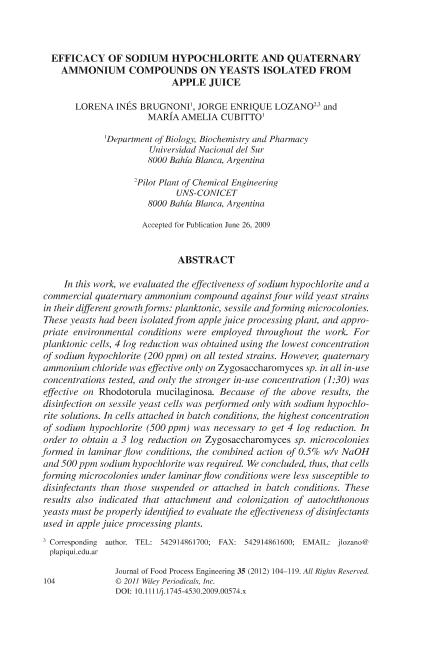Mostrar el registro sencillo del ítem
dc.contributor.author
Brugnoni, Lorena Inés

dc.contributor.author
Lozano, Jorge Enrique

dc.contributor.author
Cubitto, María Amelia

dc.date.available
2018-08-16T17:42:58Z
dc.date.issued
2012-02
dc.identifier.citation
Brugnoni, Lorena Inés; Lozano, Jorge Enrique; Cubitto, María Amelia; Efficacy of sodium hypochlorite and quaternary ammonium compounds on yeasts isolated from apple juice; Wiley Blackwell Publishing, Inc; Journal Of Food Process Engineering; 35; 1; 2-2012; 104-119
dc.identifier.issn
0145-8876
dc.identifier.uri
http://hdl.handle.net/11336/55938
dc.description.abstract
In this work, we evaluated the effectiveness of sodium hypochlorite and a commercial quaternary ammonium compound against four wild yeast strains in their different growth forms: planktonic, sessile and forming microcolonies. These yeasts had been isolated from apple juice processing plant, and appropriate environmental conditions were employed throughout the work. For planktonic cells, 4 log reduction was obtained using the lowest concentration of sodium hypochlorite (200 ppm) on all tested strains. However, quaternary ammonium chloride was effective only on Zygosaccharomyces sp. in all in-use concentrations tested, and only the stronger in-use concentration (1:30) was effective on Rhodotorula mucilaginosa. Because of the above results, the disinfection on sessile yeast cells was performed only with sodium hypochlorite solutions. In cells attached in batch conditions, the highest concentration of sodium hypochlorite (500 ppm) was necessary to get 4 log reduction. In order to obtain a 3 log reduction on Zygosaccharomyces sp. microcolonies formed in laminar flow conditions, the combined action of 0.5% w/v NaOH and 500 ppm sodium hypochlorite was required. We concluded, thus, that cells forming microcolonies under laminar flow conditions were less susceptible to disinfectants than those suspended or attached in batch conditions. These results also indicated that attachment and colonization of autochthonous yeasts must be properly identified to evaluate the effectiveness of disinfectants used in apple juice processing plants.
dc.format
application/pdf
dc.language.iso
eng
dc.publisher
Wiley Blackwell Publishing, Inc

dc.rights
info:eu-repo/semantics/openAccess
dc.rights.uri
https://creativecommons.org/licenses/by-nc-sa/2.5/ar/
dc.subject
Yeast
dc.subject
Biofilm
dc.subject
Cleaning
dc.subject
Disinfectant
dc.subject
Stainless Steel
dc.subject.classification
Alimentos y Bebidas

dc.subject.classification
Otras Ingenierías y Tecnologías

dc.subject.classification
INGENIERÍAS Y TECNOLOGÍAS

dc.title
Efficacy of sodium hypochlorite and quaternary ammonium compounds on yeasts isolated from apple juice
dc.type
info:eu-repo/semantics/article
dc.type
info:ar-repo/semantics/artículo
dc.type
info:eu-repo/semantics/publishedVersion
dc.date.updated
2018-07-11T13:48:21Z
dc.journal.volume
35
dc.journal.number
1
dc.journal.pagination
104-119
dc.journal.pais
Reino Unido

dc.journal.ciudad
Londres
dc.description.fil
Fil: Brugnoni, Lorena Inés. Universidad Nacional del Sur. Departamento de Biología, Bioquímica y Farmacia; Argentina. Consejo Nacional de Investigaciones Científicas y Técnicas; Argentina
dc.description.fil
Fil: Lozano, Jorge Enrique. Consejo Nacional de Investigaciones Científicas y Técnicas. Centro Científico Tecnológico Conicet - Bahía Blanca. Planta Piloto de Ingeniería Química. Universidad Nacional del Sur. Planta Piloto de Ingeniería Química; Argentina
dc.description.fil
Fil: Cubitto, María Amelia. Universidad Nacional del Sur. Departamento de Biología, Bioquímica y Farmacia; Argentina
dc.journal.title
Journal Of Food Process Engineering

dc.relation.alternativeid
info:eu-repo/semantics/altIdentifier/doi/http://dx.doi.org/10.1111/j.1745-4530.2009.00574.x
dc.relation.alternativeid
info:eu-repo/semantics/altIdentifier/url/https://onlinelibrary.wiley.com/doi/abs/10.1111/j.1745-4530.2009.00574.x
Archivos asociados
